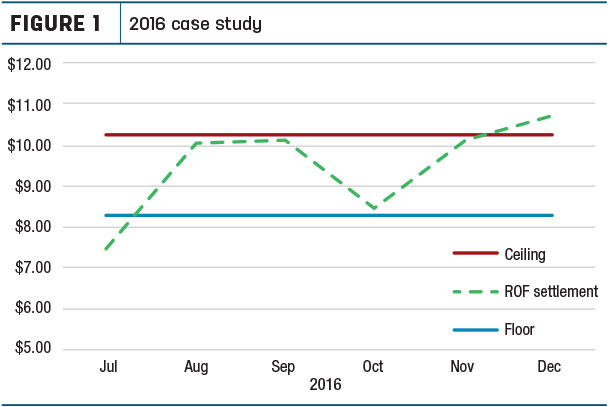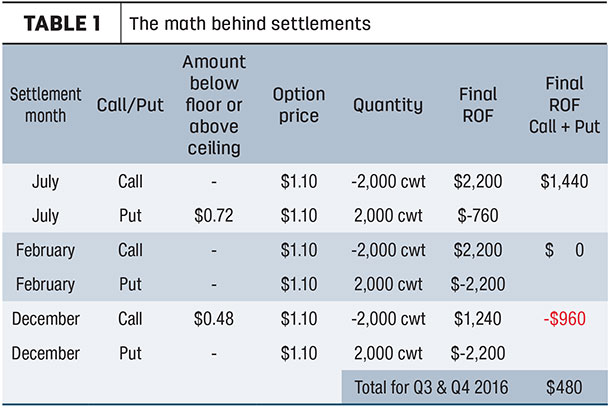It’s not too late to manage your risk for 2017. While the deadline to participate in the Margin Protection Program (MPP) has passed, producers still have the opportunity to plan and implement a risk management plan for 2017.
If a producer defaulted to the MPP $4 coverage for 2017 because they were tired of the program’s performance, or if they simply didn’t have time to look at the choices during the harvest season, that’s OK.
While the government-subsidized program may have seemed attractive at first, there are other risk management programs offered that are still open for enrollment. Don’t leave your entire profit up to the chance of the market.
The major components in determining profit are milk prices, feed costs and other inputs. The other inputs are the set costs of running a dairy, like infrastructure. That number should be unique to every producer’s farm. The other two factors – milk and feed – are controlled by the markets.
To get a more accurate idea of how your dairy tracks the markets, you can look at where December Class III milk settled – $17.40 per hundredweight (cwt) and what you were paid. The same idea can be applied to your cost of feed.
Knowing the cost of your other inputs and how far your prices are from the markets is an important step in building your risk management plan.
Two alternative programs to MPP
Our group is currently offering two different types of flexible hedging strategies for producers: Revenue over feed (ROF) and revenue over feed lite. ROF takes the cost of inputs and the price of outputs and creates a simple formula to determine margins:
ROF = milk - feed
These are tradable commodities that can be bought and sold to lock in future prices. With ROF, producers only have to worry about that one number, making sure it accurately reflects their on-farm costs. We take care of hedging the multiple inputs.
When ROF settles below the floor, the producer is paid, and when margins are good, ROF settles above the ceiling the producer has to pay out. Most producers choose a floor and ceiling that can be done at little to no cost based on option premiums.
The option premium is a number determined by the market, and it changes as the market fluctuates. (For those who are curious, those numbers are updated daily on our website.) Generally, attractive option premiums are easier to obtain by hedging further out where markets are less predictable.
While ROF and MPP do not use the same formula to calculate prices and settlements, they are highly correlated and both demonstrate similar-basis behavior relative to actual dairy profit margins. ROF settles at the end of every month, unlike MPP’s two-month settlements.
We have also designed a program for producers who have already “hedged” the forage portion of their ration by growing it. This is called revenue over feed lite. For these producers, the program works in the same way as ROF, but the numbers are slightly higher since the forage component of the ration is not included.
ROF is a uniquely flexible hedging program that lets producers create the perfect risk management plan for their dairy. Producers can hedge up to 50 percent of their annual milk production in as small as 250-hundredweight contracts.
There are no additional transaction costs and no margin calls to complicate the process. By using your own numbers, you can build a hedging program that perfectly fits your needs.
At the beginning of December, the milk price for 2017 surged while feed prices fell, generating excellent ROF margins. It was settling at $10.24 per cwt, the highest point this year. Opportunities like that don’t come around every month; when they do, it is important for a producer to be ready to take advantage of them.
Case study: How it worked in 2016
Here’s an example of how a dairy would have fared during the last six months of 2016 if it had ROF coverage. This case study uses a real customer’s choices and actual settlement prices.
In this scenario, a producer signed up for our ROF program for July through December for 2,000 hundredweights per month. He picked a $8.25-per-cwt floor and a $10.25-per-cwt ceiling at the option price of $1.10 for the floor and $1.10 for the ceiling, putting his trade at even money with no up-front cost. Here’s how the first six months settled (Figure 1).

The market moved quite a bit during the second half of the year with ROF settlements ranging from $7.53 to $10.73. Due to this producer’s planning, he was able to stabilize the price swings with his ROF coverage.
In July, ROF settled at $7.53, $0.72 below the chosen floor, and the producer was paid $1,440. When ROF settles in between the floor and ceiling, like it did August through November, nothing happens.
In December, ROF settled $0.48 above the chosen ceiling, so the producer had to pay out $960. Keep in mind December milk settled at $17.40, so margins were higher.
Essentially, producers only pay out when margins are better than what was expected. At the end of 2016, participating in an ROF program netted the producer an extra $480 on top of his normal milk profits.
The math behind the settlements

To calculate payouts that settle below the floor we use this formula:
(amount below floor – option price) x quantity
In our case study, that means ($0.72 -$1.10) x 2,000 = -$760. The ceiling is calculated with this formula:
(option price x quantity) or $1.10 x 2,000 = $2,200
The total of those two numbers is $1,440.
To calculate amount owed when ROF settles above the ceiling, we use this formula:
(option price - amount above ceiling) x quantity
In our case study, that means ($1.10 - $.48) x 2,000 = $1,240. The floor is calculated with this formula:
(option price x quantity)
or $1.10 x 2,000 = $2,200. The total of those two numbers is $960.
Knowing your numbers, knowing the market’s numbers and understanding the programs available to you are important steps toward effectively managing your dairy’s risk.
Evaluate your numbers, sign up for market notifications and compare available programs to find the best fit for you. ![]()
The ROF program is offered by CSC Arbitrage group (Ag Hedge Desk), which specializes in trading agricultural products. Trading in futures products entails risks of loss which must be understood prior to trading and may not be appropriate for all investors.
Tess Wilson is with Commodity Specialists Company. Email Tess Wilson.





